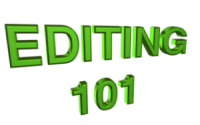 Self-Editing Part 2
Self-Editing Part 2
Last week in Self-Editing Part 1 we talked about some specific tasks that can be done while self-editing.
Today we’re going to talk about tasks involving grammar.
Grammar was developed to make writing understandable since you’re not there to correct any misunderstandings.
Your writing needs to stand on its own two feet!
-
Using commas properly. The first use of the comma is to replace the word “and.”
-
-
I went to the store and bought apples and pears and bread and milk.
-
I went to the store, buying apples, pears, bread, and milk.
-
The first example is not wrong, but the excessive use of the word “and” makes it hard to read. A comma is generally not used with the word “and” except for the last item in a series (if you are using the serial, or Oxford, comma):
-
Incorrect: I went to the store, and I bought apples, and pears, and bread, and milk.
Some writers insert commas where they would pause while speaking the sentence aloud. This can be a helpful way to punctuate, but some of the commas will not be correct and it may lead to unnecessary commas.
The second use of a comma is to separate segments (or clauses) of sentences so they are more understandable to the reader or indicate exactly what the writer intends. An example is this famous sentence. The placement of commas around the middle segment changes the meaning of the sentence:
-
Woman without her man is nothing.
-
Woman, without her man, is nothing.
An editor may add commas to such a sentence based on the context of the surrounding sentences, but a good editor will add a question mark or a query stating the meaning is unclear and indicating they’re a suggestion only. The final decision must be made by the author, who is the only one who knows exactly what they intended to write.
There are other uses of commas, but we’ll leave it at that for today.
-
If a comma is a pause in a sentence and a period (or full stop) is a complete stop, then the semicolon is somewhere in the middle. It indicates a pause longer than a comma but shorter than a full stop. It is used to join two full sentences with the same ending punctuation together, like this:
-
Tell me what you need; I’ll help if I can.
You cannot use a semicolon to connect two sentences with different ending punctuation. I see this common, incorrect construction frequently:
-
Why don’t we go that way; we have to go by there anyway.
The first sentence is a question, which requires a question mark.
-
Why don’t we go that way? We have to go by there anyway.
Semicolons are also used in lists of objects where a comma is needed in the middle of the list to separate other items. If you used all commas, confusion might result:
-
We’re going to take Paul White; Sandi Smith; Heather DeLand; Rick, Isabelle, and Rocky Fox; the Martinelli’s; and Patty Braun to the party with us.
-
Fred went out with Janet, his girlfriend; and his secretary.
Please note that Microsoft Word’s spell and grammar check is not reliable when it comes to commas and semicolons. It particularly does not like semicolons.
Next week we’ll continue with ‘Self-Editing Part 3’
 Susan
Susan

Reblogged this on The Owl Lady.
LikeLiked by 2 people
Thanks Viv ❤️
LikeLike
Thank you, Viv! New photo? It looks very nice. 😀
LikeLiked by 1 person
Great explanation here on semicolon use Susan. Thanks again. 🙂
LikeLiked by 2 people
Thanks, DG. I see the statement + question construction all the time! 🙂
LikeLiked by 2 people
🙂
LikeLiked by 2 people
I enjoy these refreshers. ❤ 😀
LikeLiked by 2 people
It’s like going back to school for something you enjoy—without the pop quizzes… 😀
LikeLiked by 2 people
If you don’t use it, you lose it. Sometimes there are stretches in between of non-use or care. That’s why I like to be reminded. 🙂 Thank YOU.
LikeLiked by 2 people
Reblogged this on TINA FRISCO and commented:
In Part 14 of her Editing 101 series on The Story Reading Ape, Susan Uttendorfsky brings us Part 2 of Self-Editing. She discusses proper and improper usage of semi-colons and commas. Consider these examples: Woman without her man is nothing; Woman, without her man, is nothing; Woman, without her, man is nothing. Hop over to Chris’ blog and enjoy the fascination of punctuation 🙂
LikeLiked by 2 people
Thanks for spreading Susan’s post Tina 😀 XXX
LikeLiked by 1 person
Thank you, Tina! ❤
LikeLiked by 2 people
You’re welcome, Chris and Susan ♥ ♥
LikeLiked by 2 people
Whether you are coming to this as a new writer or one who just needs a refresher course to get back on track, it is an enlightening series of articles. Thanks for the post and thanks for taking time out to share your insights
LikeLiked by 2 people
Thanks for reading and commenting, Paul!
LikeLiked by 2 people
My pleasure Susan, it is a very very good series
LikeLiked by 2 people
Reblogged this on Writing for the Whole Darn Universe.
LikeLiked by 2 people
Thanks for sharing Malia Ann (Part 3 is next Friday) 😃❤️
LikeLike
Thank you, Malia Ann! I hope the Whole Darn Universe likes it. 😉
LikeLiked by 2 people
Ha! Me, too! And you’re welcome! 🙂
LikeLiked by 2 people
Reblogged this on Don Massenzio's Blog.
LikeLiked by 2 people
Thanks Don 👍😃
LikeLiked by 1 person
You’re welcome
LikeLiked by 1 person
Thanks again, Mr. Massenzio! 😀
LikeLiked by 2 people
You’re welcome
LikeLiked by 2 people
Reblogged this on Plaisted Publishing and commented:
Editing 101 Part 2
LikeLiked by 2 people
Thanks for re-blogging Claire 😀
LikeLike
Thanks again, Claire! ❤
LikeLiked by 1 person
Welcome 🙂
LikeLiked by 2 people